DRINKING AND ALCOHOLIC DRINKS IN JAPAN
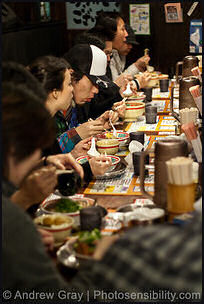
Japanese have traditionally consumed sake (clear rice wine). They quickly developed a liking for beer and whiskey after they were introduced from the West in the mid 1800s.Beer is the most popular alcoholic drink (Japan is the world's seventh largest beer market) but wine has gained in popularity in recent years. Alcoholic beverages such as wine, sake, and whiskey are sold in Japanese vending machines that are found virtually everywhere, even at the end of hiking trails on the top of Mt. Fuji and other mountains.
The Japanese have traditionally consumed “umeboshi” (pickled plums) as a remedy for hangovers. It is also touted by the Hollywood nutritionist Esther Blum for relief after a night of heavy drinking.
Alcoholic beverages are expensive, partly because there is a high tax on them. Taxes on alcohol account for 4 percent of national tax revenues. Of this beer generates the largest share. Liquor advertising is allowed on television.
The drinking age in Japan is 20. There are no restrictions on times for buying liquor. Regular customers at restaurants sometimes keep their own bottle of whiskey there. About 35 percent of beer and 50 percent whiskey is consumed at bars and restaurants.
At one time there were 170,000 alcohol vending machines in Japan. Alcohol could be purchased from them until 11:00pm. Concerns about drunkenness and underage drinking promoted the number to be reduced. There is a plan for current vending machines that sell alcohol to be replaced with machines that check the age of customers by scanning IDs such as driver licences.
According to a 2008 survey of the Health, Labor and Welfare Ministry, 83.1 percent of men and 60.9 percent of women drink alcohol. For the 20- to 24-year-old age group, the male rate was 83.5 percent, a decrease from the 2003 survey, while the female rate was 90.4 percent, topping the men's rate and an increase of about 10 percentage points from 2003. [Source: Mitsunobu Sato, Yomiuri Shimbun, July 29, 2012]
Good Websites and Sources: Good Photos at Japan-Photo Archive japan-photo.de ; Drinking and Drinks japanvisitor.com ; Blog Report on Alcoholic Drinks in Japan howtojapan.blogspot.com ; Alcohol in Japan Washington University in St. Louis ; Alcohol Consumption in Japan cmaj.ca/cgi ; A Night at a Tokyo Bar pubclub.com ; Bars and Night Clubs in Japan barsjapan.com ;
Links in this Website: DRINKING AND ALCOHOLIC DRINKS IN JAPAN Factsanddetails.com/Japan ;BEER IN JAPAN Factsanddetails.com/Japan ; SAKE AND SOCHU Factsanddetails.com/Japan ; TEA AND NON-ALCOHOLIC DRINKS IN JAPAN Factsanddetails.com/Japan
Alcohol Consumption in Japan
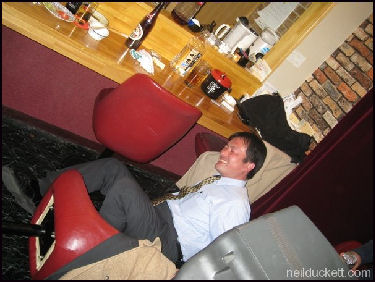
drunk salaryman falls on his ass Japanese consume about eight liters of pure alcohol per person per year. The French are the largest consumers of alcohol, consuming about 12 liters of pure alcohol per person. Americans consume about 7 liters.
Alcohol consumption surged, especially among women and young people, between the 1960s and 90s. The annual consumption rate has increased from 5.8 liters per person per year in 1965 to 8.5 liters in 1997.
Now alcohol consumption is declining. Total consumption declined from a peak of 10.2 million kiloliters in 1999 to 9.4 million kiloliters in 2006. The decline has been attributed to a declining and aging population and changes in social norms. One beverage analyst told Reuters, “Overall Japanese do no not drink as much as they used to.”
A survey by the Nikkei Marketing Journal in 2007 found that 34 percent of people in their 20s never or rarely drink alcohol.
After strict drunk driving laws were imposed the market for non-alcoholic beer-like drinks grew.
Alcohol and Japanese
About half of all Asians lack an active enzyme which breaks down acetaldehyde, a toxic chemical derived from ethanol found in most forms of alcohol. As a result, when they drink their face turns red and they get sick to their stomach easier than Westerners who have this enzyme.
Many Japanese like to get drunk because it is the only time when they can really let themselves go and say what they think. Losing yourself and making a fool of yourself are not seen as bad things but a sign that you have let your guard down and can be yourself with your friends. Some Japanese even pretend they are drunker than they really are so they can speak their mind openly. Some Japanese believe that the only way to really get know someone is to get drunk with them, and sometimes regard people who won't drink as arrogant or having something to hide.
Drinking, work and business go hand and hand in Japan and a major reason why salarymen come home so late every night. "Its dangerous to refuse your bosses's offer to go drinking," one Japanese journalist told National Geographic. "Very important decisions are made in drinking spots." Other Japanese have said if they don't go drinking with their boss, they risk not getting a promotion.
Japanese Drinking Customs
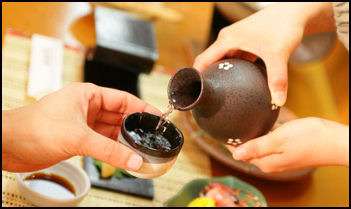
Japanese usually don't start drinking until someone offers the toast "”kampai”" — (dry glass). The Chinese and Koreans use the same word for their toasts. As the evening progresses, Japanese often shout "banzai!" three times. It means "live ten thousand years" and is the equivalent of saying "hip. hip, hooray!" The custom of raising a glass and saying a loud toast caught on in the later half of the Meiji Period (1868-1912) and was influenced by the British Royal navy.
When drinking, one should not drink from the bottle or fill his or her own glass. The polite thing to do is fill someone else's glass and they in turn will fill yours. In some situations, it is rude to turn down a drink that is being offered to you. To avoid drinking to much keep you glass full. To avoid being rude accept a drink the first time it is offered to you by a particular individual. The second time he offers it is acceptable to politely say no.
These days Japanese often order beer by the glass rather than the bottle which means they are less likely to pour drinks for each than they did in the past. Often younger people hold the bottle with one hand when pouring for older people when etiquette requires them to hold it with two hands. This trend is attributed to decline if drinking between older and young people.
“Kakuuchi” describes the custom of stopping at a sake shop, throwing a coin on a counter, ordering a sake, gulping it down with one gulp and hitting the road. It used to be a popular custom among factory workers on their way home from work in working class neighborhoods and is associated with Kita-Kyushu. Today the custom is kept alive mostly by old timers but is making a comeback in some places.
Drinking Parties in Japan
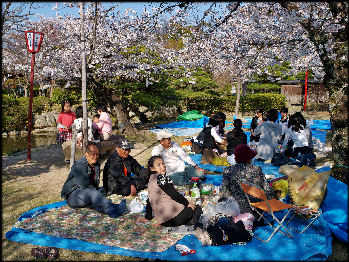
cherry blossum party “Nenmatsu” (the year’s end) and “nenshhi” (year’s beginning) are the traditional seasons for heavy drinking. It is not unusual for people to participate in numerous “bonenkai” (“forget this year” parties) in December, including work-related ones with coworkers and bosses, clients and business associates. University students have bonenkai organized by clubs and associations. Community, neighborhood and senior associations have their own. The drinking continues well into January.
In December 2008, a 51-year-old primary school teacher that drank too much at a year end party was killed in Kitakyushu when she leaned over the platform to get sick at a train station in Kitakyushu and was hit by an oncoming freight train. The driver of the train tried dot stop. Vomit was found on the track.
Heavy Drinking and Drunkenness in Japan
There is an old saying: "Although sake is said to be the king of 100 medicines, it causes thousands of ailments." The number of heavy drinkers increased from 1 million in 1965 to 2.5 million in 2000.
According to one survey the proportion of Japanese men who have like to drink three or more times per week and have the equivalent of 180 milliliters of sake has remained steady at around 50 percent since 1986. A survey by found that the average salaryman spends an ¥4,851 on a typical night out. The number of women who like to drink that amount rose from five percent to nine percent between 1986 and 1998.
Public drunkenness is more acceptable and commonplace in Japan than the United States, especially among business men in suits. In entertainment districts throughout Japan, almost any night of the week, you can find drunk salarymen stumbling down the sidewalks and even passed out beside the side of a road. Occasionally they fall off platforms at train stations but are usually pulled to safety from the tracks before a train comes.
The drinking districts are often full of drunk salarymen talking loudly, laughing and singing in streets and urinating in the alleys. It is not unusual to be sitting next to drunken men on subways that reek of alcohol and cigarettes and are snoring away in their seat. Such behavior is often more tolerated in Japan than it is in the United States.
Drunkenness usually involves nothing more than boisterous singing karaoke and toppling over when bowing farewell to their friends. Japanese drunks are often attracted to foreigners, sometimes attempting to strike up a conversation, other times being harassing or insulting. Even so, drinking rarely leads to violence. A “daiko” is a taxi driver who patrols bars late at night picking up drunk patrons who pay many times the regular fee to get home.
Sometimes drunks fall off the platforms at the train stations. Once a 55-year-old drunk women who fell on the tracks saved herself from being killed by lying between the rail as a train screeched to halt above her.
Hangovers are called “futsukayoi” (“two day drunk”)
Female Alcoholics on the Rise in Japan
According to a 2008 survey of the Health, Labor and Welfare Ministry, 83.5 percent of men in the 20- to 24-year-old age group and 90.4 percent of women in the same age group drink alcohol. Mitsunobu Sato wrote in the Yomiuri Shimbun: “With the survey showing an increase in the number of women in their early 20s who drink, there is growing concern that more young women are drinking heavily. Although men often become alcoholics 20-30 years after they start drinking, women can become addicts within 10 years of their first drink. Women's livers are smaller than men's and therefore less able to break down large amounts of alcohol. [Source: Mitsunobu Sato, Yomiuri Shimbun, July 29, 2012]
Diagnosed as an alcoholic 20 years ago, Yoko Kojima, 52, said her father was also an alcoholic and became violent when drunk. Her family environment was rough, and she began using illegal drugs in her teens. She stopped using drugs when she took over the family business and her responsibilities increased, but soon turned to alcohol to relieve her stress. Her alcohol intake gradually increased, and at the age of 32 she was diagnosed as an alcoholic.
Mitsunobu Sato wrote in the Yomiuri Shimbun: “Kojima has managed to stay off the bottle, partially through the help of an alcoholics support group, and now works to help women suffering from the same addiction at an all-female alcohol treatment center in Kanagawa Prefecture. The facility, called Indah, is located in Seya Ward, Yokohama. Opened in January, it is the first treatment center in the prefecture dedicated solely to helping female addicts. [Source: Mitsunobu Sato, Yomiuri Shimbun, July 29, 2012]
Specialists say more facilities exclusively for women are necessary, as they provide environments where recovering addicts can feel comfortable speaking about their experiences and maintaining the will to stay sober. Despite the rising number of female alcoholics, the nation has few such facilities.
Some time after her diagnosis, Kojima began attending such meetings daily. Six years later, she joined the staff at a care facility for alcoholics in Yokohama. However, she said she felt uncomfortable in meetings where men were present. "Women often start drinking because of a traumatic relationship with a father, husband or boyfriend," Kojima said. "It's hard for some women to talk openly about these experiences in front of men." Furthermore, many female alcoholics have been physically abused by male addicts. "Some women were so scared of male alcoholics that they couldn't attend meetings even though they wanted to," Kojima said.
Kojima said she noticed other problems that would crop up in mixed male-female settings at the treatment center. "Female alcoholics often have a sense of self-denial. They like to care for weak-willed men who have succumbed to drinking, while male alcoholics are attracted to women who like to help others," said Kojima. "These two types frequently fall in love, and sometimes start drinking again together.”
Indah is open from 9 a.m. to 5 p.m. every day. About 20 women registered through medical institutions are able to use it free of charge. At the 90-minute daily meeting, participants discuss various themes, such as "changing yourself" or "recognizing your addiction." They are encouraged to speak openly about their problems, temptations to drink, and so on.
One of only about 10 such facilities throughout the nation, Indah is currently run by Kojima and another woman, who both work without pay. They are hoping to raise money to relocate to a more spacious building by the end of this fiscal year, and they also want to obtain financial assistance from the Yokohama municipal government so they can provide support for those looking for work.
"Some female alcoholics experience depression or panic attacks after they stop drinking because they remember the verbal or physical abuse they had suppressed when they were drinking," said Sakae Fujita, a psychiatric social worker at the Kurihama Medical and Addiction Center in Yokosuka, Kanagawa Prefecture. "They are incredibly delicate and require attentive, considerate care. I think facilities exclusively for female addicts will be very effective.”
Young People and Drinking in Japan
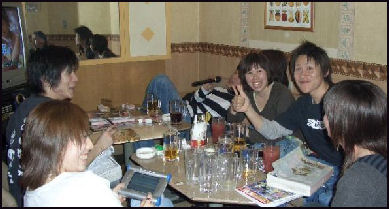
Heavy drinking is associated most with middle-aged men. Bar owners often complain that young people simply don’t like to drink. A study by Kirin found that the percentage of men and women in their 20s who had a drink in the last three months declined from 79.8 percent in 1994 to 73.7 percent in 2003. A survey by the Nikkei Marketing Journal in 2007 found that 34 percent of people in their 20s never or rarely drink alcohol.
Many attribute the trend to the fact young people have less money. One izakaya owner in Shinjuku told the Daily Yomiuri, “Unlike before, there aren’t many students who get excited by a heavy session of binge drinking. These days many students just cradle their drinks, trying not to spend too much money on booze.” Others attribute the trend to cell phone and Internet culture in which social contact is carried out through sending messages rather than sitting down and enjoying a drink together.
A lot of young people drink. A study in 1996 found that more than half of male high school seniors drank alcohol at least once a month. Most of them get alcohol at home, from vending machines or from convenience stores that generally don't card consumers. It has become more common for young drinkers to consume hard liquor and cocktails in bars. For university students, the cherry blossom and welcome party season in the spring and university festival season in the fall are particularly popular time for binge drinking and “ikki” (forced drinking and chugging).
There is also evidence that many young people don’t know how to drink. Drunkenness and alcohol poisoning have become serious problems among young people. According to the Tokyo Fire Department 6,606 people in the their 20s were taken to the hospital by ambulance because of acute alcohol poisoning in 2005, compare to 4,209 in 1995. Attention was drawn to the issue after a couple of students died from over drinking.
In January 2008, a high schools boy ran up a tab at bar in Niiza, Saitama Prefecture, of ¥370,000 (around $3,000) even though he had now money as was 16, four years below the legal drinking age. The boy showed up at the bar at 10:30pm. He bought two bottles of expensive champagne and 60 glasses of whiskey and cocktails and asked for four or five hostesses to attend to him. He was arrested around 4:00am.
Japanese Bars

Japan has more drinking places per capita than many countries in part because people have so little room in their homes and go out when they entertain and socialize. Another reason is they are small so there are a lot of them. Bars and restaurants filled with cigarette smoke. "Bottle keep" refers to custom of keeping your own bottle of liquor at a bar that you frequent regularly.
The bars in Japan can be surprisingly tiny and cramped. Standing bars in urban Japan often seem as if they are no bigger than closets. Many people drink in small neighborhood bars that often have fewer than a dozen seats. These places are more like a bar in someone’s house than a bar on the street. They usually have regular customers who are a bit shocked when strangers come in. Sometimes the people that run the places are quite insulting to the customers but the customers don’t mind and in fact find it refreshing as an escape from humdrum politeness of Japanese life.
Sunakku are small neighborhood bars. They typically have snacks and alcoholic drinks, often served from bottles the customers bring themselves or have reserved for they. The bars are typically run by women of varying ages known as sunakku “mamas” who are known for cheering up customers and lending a sympathetic ear to their problems and knowing how to handle them when they get too drunk.
“Tachinomi” (“standing bars”) are popular who want a quick, cheap drink. They are especially popular in central Tokyo where space is of a premium and property in expensive. The author a guide book on tachinomi told the Yomiuri Shimbun, “Drinking this way uses the available space optimally and allows as many people as possible to enter a small bar.”
The bottle keep system, which allows customers to supply their own liquor or have names affixed to bottles of whisky or sake in the bar, is way to make sure the customers come back.
The Pardennen bar in Kobe charges customers by the amount of time they spend in the bar not the amount of food or liquor they consume. Everyone pays $4 for the first ten minutes, with men paying 23 cents a minute after that and women 10 cents. Discos in Japan often charge one price to get in the door and then have unlimited food and rink buffets inside. [Source: Leonard Cohen, Discover magazine, June 1988. Cohen has written a book called "283 useful Ideas from Japan]
Kinds of Japanese Bars
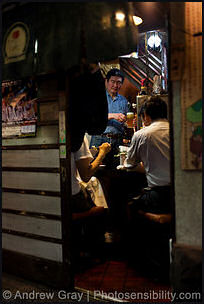
“Izakaya” are drinking restaurants. They offers a variety of drinks but generally serve mostly beer and to lesser extent sake and have a wide range of small, tasty dishes and snack food such as yakitori (small kebab-like foods), grilled fish and sashimi. Customers can sit at the bar, a table or on a tatami mat floor. Parts of the kitchen are often expose so customers can see the food items being prepared. There is a lot of interaction between the staff and customers. Izakyas are often identified by red lanterns outside their doors.
Izakayas have traditionally been places were company employees drank with their work mates and young people gathered to party. Equal emphasis is put on eating and drinking. The food items come in small portions and are meant to be savored and shared. They are definitely tasty but some complain are overpriced. If you let you guard down and order too many you can end up with a hefty bill.
Yakitori Bars are izakaya that specialize in yakatori. Tachinomiya are “new-style stand up izakayas. “Robatayaki” are drinking restaurant with grilled foods. They are similar to izakaya except they specialize in meats grilled over a charcoal fire.
Nightclubs are generally very expensive and some have colorful floor shows and hostesses that are paid to chat with male customers. Hotel Bars are lounges or bars found in first class hotels. Their atmosphere is cozy and many are located on the top floor of the hotels, where there are wonderful views of the city.
Beer Halls and Beer Gardens are plentiful in Japan and prices vary a great deal from place to place. In many cities the roofs of large buildings have been converted into beer gardens which are open from May to early September. Inexpensive Downtown Pubs are clustered in the downtown areas of the large cities. Seating anywhere from 50 to 200 people, these pubs fill up with office workers of all ages and both sexes after 7:00pm.
Karaoke-Boxes are karaoke-style singing rooms. Very popular in Japan, they consist of rooms large enough for a group of friends and are rented by the hour. Generally you buy drinks at bar and bring them to your room. These days they are more common than karaokes.
There also discos (not many though), gaijin bars (bars where foreigners hang out), hostess bars (where men are served and flattered by women) and host bars (where women are served and flattered by men). You can also find live music clubs that specialize in a particular kind of music such as jazz, techno, blues or punk rock. Thee are also theme bars such Irish pubs and Sports bars. Soaplands, Turkish Baths and Image Rooms are kinds of sex clubs. Some restaurants and bars feature all you can eat and all you drink deals that often have a time limit of one or two hors.
Hostess Bars in Japan
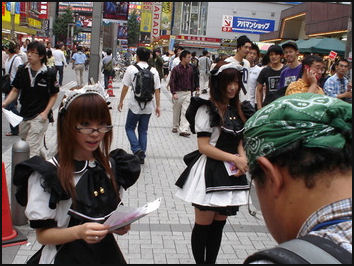
maid-hostesses seeking customers in Akihabara In Japan, there are about 220,000 hostess bars, where young ladies entertain, chat up, and flatter male customers and up light their cigarettes and pour their drinks. The women generally don't have sex with the male customers. They are generally prohibited by their employers from dating their customers after they get off work.
Describing one Tokyo hostess bar, Boyd Gibbons wrote in National Geographic: "The hostesses descended — the men love this — pouring the Scotch, patting their ego. In their dressing rooms the women have charts of quotas they must push. If a customer welshes on his monthly tab, the hostess has to pay the bill. Few can afford to. The goons move in, pay her debt, force her out of the bar and into bed. The hostess beside me was exhausted. 'I like drinking. I drink when I'm depressed. This life is really awful,'" she said. [Source: Boyd Gibbons, National Geographic, February 1992]
Women who have worked as hostess have said it is hard work to make conversation with and flatter their customers. At some hostess bars the women are told to act like mothers too their clients and required to read the books written by professors who are their clients so they can chat about the book’s contents.
These days competition is stiff between clubs and a great effort is made to find new customers. Hostesses are encouraged to act more like prostitutes than before. Bottakuri are rip off joints that give customers widely inflated bills. A law outlawing them was only passed in 2001.
See Living, Sex, Sex Industry
Bar Scams in Japan
An investigation found that at least five bars in the Kabukicho entertainment district were involved in a scam to get customers drunk and use their cash cards to take money resulting in more than $400,000 being taken. In some cases a person from the bar would accompany the victim to ATM machine and record his Pin number as he typed it and then steal his cash card after passing out from too much drink and withdraw money.
Police in Ueno in Tokyo have received a number of complaints of hostesses that get their customers exceptionally drunk and then encourage them to withdraw large amounts of money — from $500 to $2000 — from an ATM and hand it over to the hostess. The hostesses seek out already drunk men on the streets, take them to their bar, get them more drunks and then take them to a convenience store with an ATM and talk them into withdrawing the money and handing it over and then leave before the drunk man can gather his wits. The victim often wake up on a park bench without any knowledge of what had happened.. Police estimate that millions of yen has been handed over in this way but are not sure how to handle the situation since no laws have been broken.
Drunk Driving in Japan
Men convicted of drunk driving are sometimes sent to special prisons where they are not permitted to speak during the meals and live in tiny cells or barracks, and make soy paste and other products. The average sentence is around 11 months.
In June 2002 the maximum fine for drunk driving was increased from ¥100,000 to ¥500,000. After the change the number of drunk driving accidents decreased significantly and the number of deaths linked with drunk driving fell from 1,191 in 2001 to 780 in 2003.
Accidents and deaths involving drunk drivers were given wide coverage in both the print and on television after the Fukuoka accident (See Below). Fans that attended the concerts of popular pop singers and parked in facilities for the concert hall were required to undergo a breath-test before being allowed to drive. Displays of the new Beaujolais were accompanied by large signs warning about drunk driving and underage drinking. Checkpoints were set up around entertainment districts nabbing dozens of drunk drivers. In one week-long campaign, 1,126 drunk drivers were nabbed, including one man who was stopped and then stopped again and arrested a few hours later.
Passengers with drunk drivers can be sentenced to jail. In January 2011, two men were sentenced to two years in prison for abetting a fatal traffic accident caused by another man — who was drunk — after giving the pair a ride after drinking alcohol in Kumagaya, Saitama Prefecture. The sentence, given by lay judges, was the first of its kind. The ruling was based on the determination that the two men were aware that the driver was drunk and turned a blind eye to a dangerous situation. The fatal accident killed a man and his wife and injured seven others. The driver got 16 years in prison.
Toyota, Nissan and other car companies are experimenting with Breathalyzer devices that won’t let a driver start his car until he passes the test. They have developed sensors that detect blood-alcohol levels in the driver palms; a system that detects erratic movements through the steering wheel; and use a camera to check if the pupils are focused. If something wrong is detected the car slows down and come to a stop. The system is expected to be ready in 2009.
After strict drunk driving laws were imposed the market for non-alcoholic beer-like drinks grew.
Drunk Driving Accidents, See Transportation, Automobiles Driving
Social Cost of Alcohol in Japan Estimated at $50 Billion a Year
The social cost of excessive alcohol drinking is 4.15 trillion yen ($50 billion) a year, according to a Health, Labor and Welfare Ministry research team. Yoneatsu Osaki, an associate professor of Tottori University, and other researchers estimated the cost using demographic statistics and patient surveys from 2008. The team also consulted a U.S. study that found 40 percent of cirrhosis cases and 34 percent of bathtub drowning deaths were caused by drinking too much. According to the team's research, excessive alcohol intake increased the number of stroke, cancer and injury victims by 246,000 and the number of deaths by 35,000. This increased medical costs by 1.02 trillion yen. [Source: Yomiuri Shimbun, February 10, 2012]
The team also estimated 1.08 trillion yen in wages that would have been earned by people had they lived until the age of 69 was lost due to heavy drinking. About 5.9 percent of male workers and 1.7 percent of female workers said they experienced problems due to excessive drinking, including damage to social relationships and taking a day off due to a hangover, the team said.
Combining the survey data with a study that claims alcohol abuse reduces labor productivity by 21 percent, the team estimated the losses stemming from alcohol-related problems at work totaled 1.97 trillion yen. If traffic accidents caused by drinking and driving were also taken into account, the total social cost would rise to between 5 trillion yen and 7 trillion yen, the same as smoking, they said. "People tend to think lightly of the damage caused be excessive drinking, but the social costs are quite significant," Osaki said.
Image Sources: 1) 7) Andrew Gray Photosensibility 2) Neil Ducket, 3) Japan Zone, 4), 6) Ray Kinnane, 5) Tokyo Pictures, 7) xorsyst blog
Text Sources: New York Times, Washington Post, Los Angeles Times, Daily Yomiuri, Times of London, Japan National Tourist Organization (JNTO), National Geographic, The New Yorker, Time, Newsweek, Reuters, AP, Lonely Planet Guides, Compton’s Encyclopedia and various books and other publications.
Last updated January 2013
